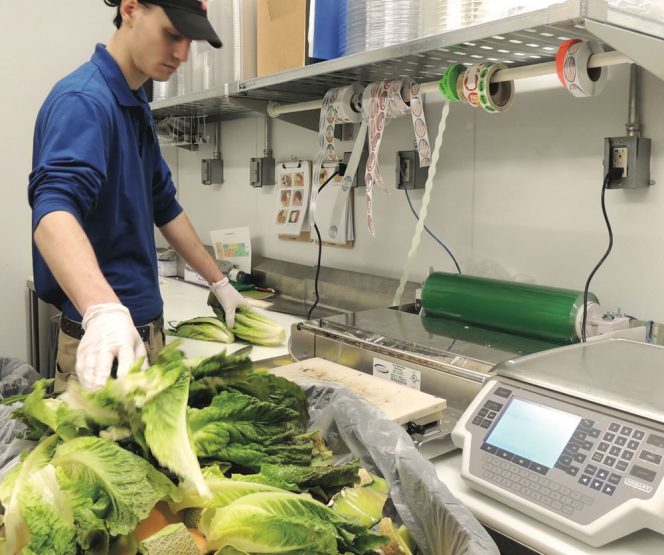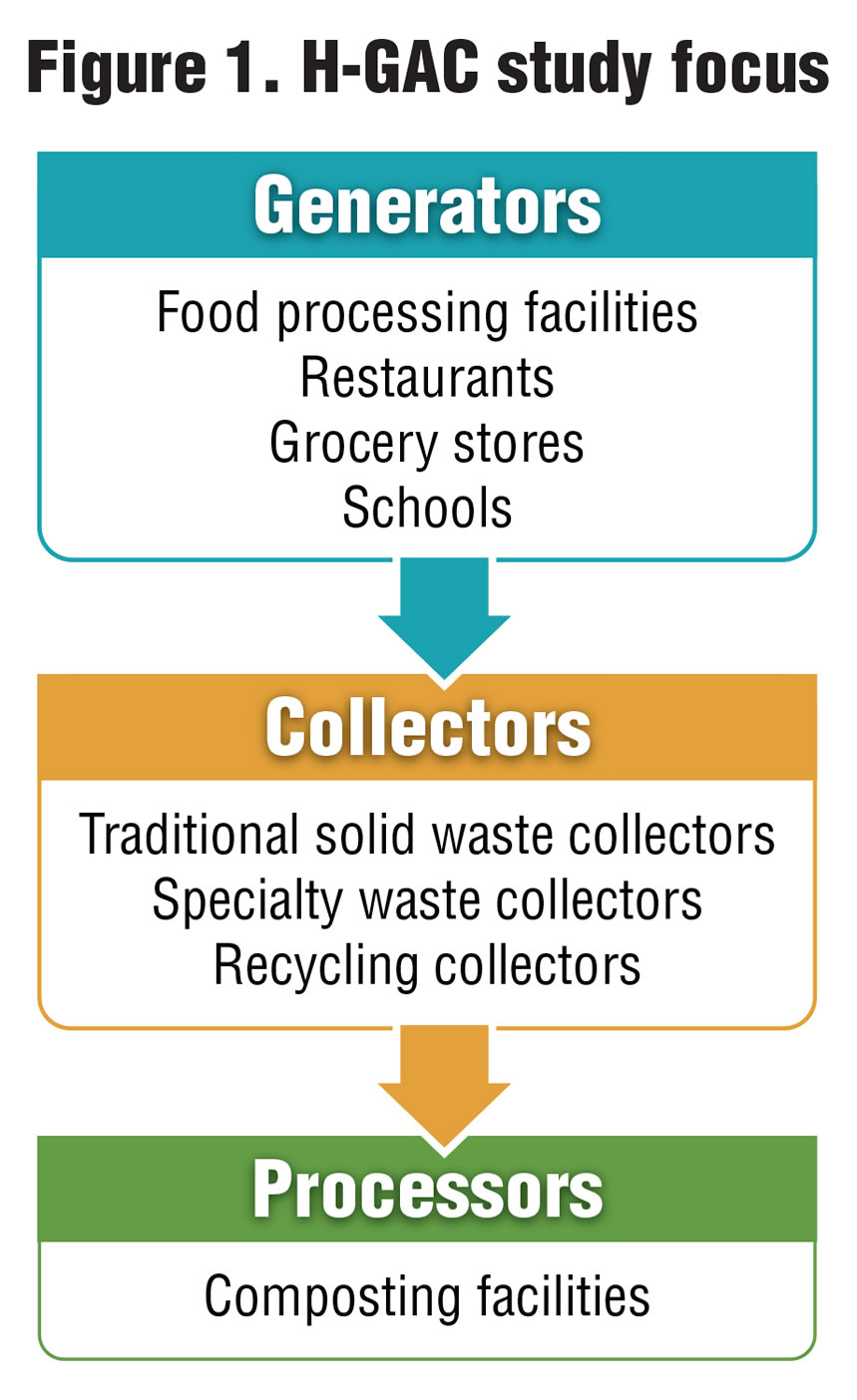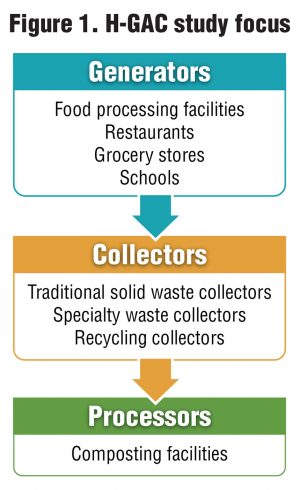Planning council explores voluntary and collaborative approaches with generators, collectors and processors to increase food waste recycling in the Houston-Galveston region.
E. Livingston, C. Mergo, S. Crain and M. Sines
BioCycle July 2016

The study determined that the largest generators of preconsumer commercial food waste in the region are food processors and retail grocery stores.
To identify how commercial food waste diversion could be increased using a voluntary and collaborative approach with the private sector, H-GAC partnered with NewGen Strategies and Solutions, LLC (NewGen), and its subcontractor Risa Weinberger & Associates, a composting consultancy, to conduct a feasibility study. The H-GAC study primarily focused on coordinating future food diversion initiatives by commercial generators, collectors and processors in the Greater Houston area. Figure 1 outlines participant categories in those three sectors.
NewGen’s initial goal was to gauge the feasibility of establishing a commercial food waste diversion program in the H-GAC region and identify entities motivated to participate. Several generators were already engaged in successful food waste reduction in the community, while many others wanted a more comprehensive and robust food recycling network. Composting infrastructure for some food waste streams existed. The following summarizes major findings of the feasibility study.
Generators
Some grocery stores and commercial food processors in the H-GAC region are active in food waste diversion. Several commercial entities, such as Whole Foods Market, donate excess, edible food to local area food banks and pantries, and some are also actively diverting food waste to composting facilities when it is not fit for human consumption.
The Houston Food Bank is currently the nation’s largest food bank where nearly 73 million pounds of food are received annually from grocery stores, retailers and distributors. This provides approximately 50 million meals to those in need on an annual basis. Unfortunately, canned items or damaged food products that cannot be distributed for human consumption are landfilled. While there is a desire to compost the food waste, constrained staffing levels limit the food bank’s ability to manually extract food and subsequently set it aside for diversion to composting.
Restaurants are not typically large generators of preconsumer food waste, which may come from over purchasing, spoilage, contamination, and food preparation (e.g., vegetable and meat trimmings). Most surveyed restaurants generate less than a 60- or 90-gallon cart/day of preconsumer food waste.
Many businesses participating in a food waste program do so because of their dedication to sustainable practices. Economic incentives are needed to motivate more businesses to recycle organics, such as low composting processing fees, competitive collection rates (vs. traditional solid waste collection), and sufficient room for the food waste collection containers.
Collectors
One of the biggest barriers to a more active commercial food waste program is lack of food waste collection companies in the H-GAC region. Currently, some national and smaller solid waste collection companies provide limited services related to food waste. However, due to low route densities, collection via these haulers is not actively promoted as a service to their customers. This often results in a higher rate than standard solid waste collection service.
Building designs and layouts at commercial businesses (primarily restaurants) can present challenges because some locations have limited room for food waste collection containers, or existing enclosure laws make it difficult to create room for additional carts. Some cities have addressed the issue with ordinances that require sufficient room for food waste containers prior to new construction permitting. Other entities have addressed this challenge with increased frequency of collection and/or revisiting their waste stream to determine whether food waste containers can potentially reduce the number of solid waste carts or dumpsters on site.
Processors
The three major private composters in the Houston area (Living Earth, Nature’s Way and New Earth) emphasized the benefits of food waste in the composting process. It provides a high concentration of nitrogen, which accelerates the composting process. Composting can be a water intensive business, and because food is largely comprised of water (60-80%), it minimizes the need for additional water sources. In 2011, during one exceptionally dry year in Texas, one composter pumped over four million gallons of water from its well to facilitate composting. Including more food waste would enable this composter to reduce use of potable drinking water.
All three private processors would like to obtain more feedstocks, however the type available to the processors depends on their Texas Commission on Environmental Quality (TCEQ) certification. As a result, certain processors are only able to accept vegetative food waste, while others can also accept meat, fat and dairy by-products. All processors overwhelmingly agree that preconsumer waste is preferred to postconsumer waste due to contamination and quality issues inherent in postconsumer food waste.
The estimated excess composting capacity available to accept and process food waste in the H-GAC region is, at a minimum, 85,000 to 95,000 tons/year.
Identifying Priorities
Staff at H-GAC, the cities of Houston and Sugar Land, and NewGen strategized the next steps to meet the short-term and mid-term initiatives as listed below. Future work based on this study will focus on implementing the following recommendations:
Short-Term Initiatives: First 12 Months
Offer a quarterly commercial food waste roundtable focused on implementing recommendations of the study. H-GAC will host a roundtable to address the key issues related to the generation, collection, and processing of food waste in the H-GAC region. In the first year (summer or fall of 2016), this group will likely focus on education, meeting with city health departments and large commercial food waste generators, and discussing solutions to the relatively high cost of collection.
Coordinate education and outreach, including development of training materials for food waste generators. While some educational materials will be developed by H-GAC, NewGen envisions the Houston Restaurant Association, Texas Restaurant Association, Grocery Manufacturers Association, and a variety of local governments taking proactive roles in the communication about local food recycling initiatives. Development of a consistent and methodical message will be fundamental to successful outreach.
Clarify materials accepted by processors. Before increasing the stream of materials provided to composting facilities, it is critical to identify acceptable feedstocks at each composting location. Additionally, there is a need to determine whether any processors are willing and able to upgrade their certifications to accept meat, fats and dairy product waste. Once that is addressed, a strategy can be finalized regarding the type(s) of food material to pursue.
Discuss potential consideration for a tiered-rate structure for incoming food waste with composting facilities. A tiered-rate structure may be considered to incentivize diversion of food waste from landfills. For example, food wastes high in liquid content, or provided via tanker truck, may warrant a discount as this can potentially reduce the amount of water required during the composting process.
Focus initial food waste diversion on commercial food processors, wholesale food distributors, and retail grocery stores. The largest generators of preconsumer food waste are food processors and retail grocery stores. Weekly generation of two to five tons is not unusual at these types of facilities.
Pursue food waste on Produce Row. “Produce Row” in Houston is a large distribution center for produce distributed to restaurants and grocery stores throughout the H-GAC region. It is served by both rail and truck. Some food waste generated at Produce Row is already diverted to composting facilities in the H-GAC region. However, additional material can be diverted from this facility — both potentially for consumption, as well as for composting.
Follow up with collection companies that currently collect solid waste or recyclables. Inquire whether they would consider expanding their collection services to include food waste. As a result of this study, several smaller collection companies have expressed interest in expanding their services to collect food waste.
Begin development of a geographic information system (GIS) database. The database would include food waste generators, collectors and processors in the H-GAC planning region. The H-GAC GIS Department will develop this database within the Greater Houston Area, allowing H-GAC to clearly identify strategically located areas that should be targeted for food waste collection.
Mid-Term Initiatives: 13 To 36 Months
Coordinate food waste diversion programs with restaurants. Although the roundtable focus in the first year will be primarily on commercial generators, H-GAC will eventually consider food scraps collection from restaurants. The pursuit of restaurants should be extended only to those that are highly motivated to participate, and may be limited to preconsumer food (at least during the pilot phase). Restaurant involvement should grow incrementally during the one to three year implementation period.
Explore food waste diversion to farms. Few chicken and hog farms were identified in the area, therefore this is not a high priority task. However, it is one that warrants further analysis.
Develop model ordinances. A model ordinance should be made available to local governments to encourage food recycling, e.g., to incentivize or mandate food waste diversion from landfills by selected generators or haulers.
Erin Livingston and Cheryl Mergo are with the Houston-Galveston Area Council. Stephanie Crain and Mandy Sines are with NewGen Strategies and Solutions, LLC, a financial and economic consulting firm working with municipal solid waste, water, wastewater, and electric utilities.











